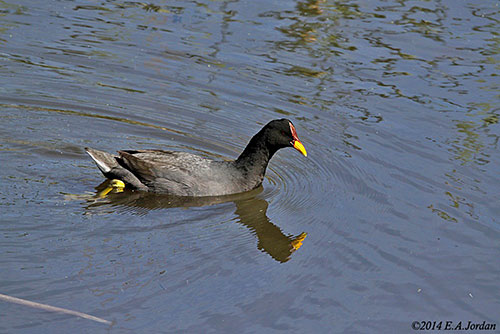
Fr: Foulque à front rouge
Ang: Red-fronted Coot
All: Rotstirn-Bläßhuhn
Esp: Focha Frentirroja - Tagua de Frente Roja - Gallareta escudete rojo
Ita: Folaga fronterossa
Nd: Roodschildkoet
Sd: rödpannad sothöna
Photographers:
Didier Buysse
Vision d’Oiseaux
Eduardo Andrés Jordan
MIS AVES – AVES DE ARGENTINA
Text by Nicole Bouglouan
Sources:
HANDBOOK OF THE BIRDS OF THE WORLD Vol 3 by Josep del Hoyo-Andrew Elliott-Jordi Sargatal - Lynx Edicions - ISBN: 8487334202
BIRDS OF PERU by Thomas S. Schulenberg, Douglas F. Stotz, Daniel F. Lane, John P. O’Neill, Theodore A. Parker III – Princeton University Press 2007– ISBN: 978-0-691-13023-1
Arthur Grosset's Birds (Arthur Grosset)
Argentavis - Gallareta Escudete Rojo
UNL - Facultad de Ciencias Veterinarias
Sistema de Información de Biodiversidad de la Administración de Parques Nacionales, Argentina
Tagua de Frente Roja Fulica rufifrons (Philippi y landbeck)
Wikipedia, la enciclopedia libre
Wikipedia, the free encyclopaedia
Red-fronted Coot
Fulica rufifrons
Gruiformes Order – Rallidae Family
INTRODUCTION:
The Red-fronted Coot is a Rallidae found in South America in Peru, Chile, Paraguay, Brazil, Uruguay and Argentina.
It frequents the shallows of semi-open marshes and reedy lakes where it can find floating vegetation, but it usually remains close to the vegetation, making it difficult to see.
It feeds at water surface when floating plants are available, and also dips the head into the water to reach submerged food.
The species is monogamous. The nest is built at water level, on floating or emergent vegetation.
The Red-fronted Coot is affected by nest-parasitism by the Black-headed Duck (Heteronetta atricapilla), but the population is stable and the species is not globally threatened at the moment.

DESCRIPTON OF THE BIRD:
Biometrics:
Length: 38-43 cm
Weight: M: 685-735 g – F: 550 g
The Red-fronted Coot has almost entirely dark slate-grey plumage, except for the white outer undertail-coverts forming an inverted heart shape. The underparts are slightly paler, especially on the breast.
It has flatter back and longer tail than other coot species.
Head and neck are blacker. The head shape shows a peaked crown.
The bill is yellow with dark chestnut ridge and frontal shield. This elongated frontal ornament intensifies both colour and size during the breeding season.
The eyes are dark red.
Legs and feet are yellow-olive. This species has not greatly enlarged lobes on feet.
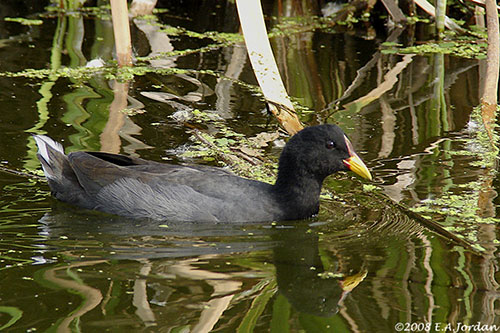
Male and female are similar.
The juvenile has uniform grey-brown plumage, a pointed shield and white outer undertail-coverts. The throat shows some white spots. The bill is blackish with restricted yellow tip. The colour changes as the bird is growing.
The immature has dark, blackish-yellow bill. The shield is absent or very small.
The chick has blackish down overall, except for the yellow-orange throat, the red bill and the bare head top. Legs and feet are black.
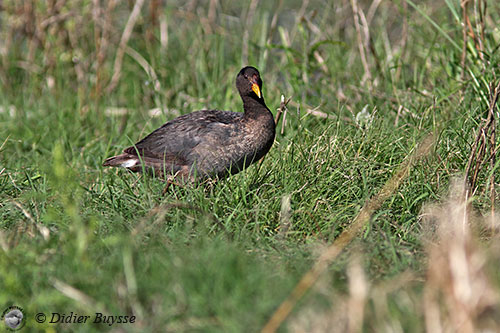
RANGE:
The Red-fronted Coot is found in coastal regions of S Peru and C Chile. It is also present in S Paraguay, coastal SE Brazil and Uruguay, S to EC Argentina (E Chubut).
HABITAT:
The Red-fronted Coot usually ranges from sea-level to 800 metres of elevation, occasionally up to 2,100 metres in NW Argentina, and regularly at 3,700 metres in Bolivia.
It is mainly a lowland species, and can be found in the shallows of semi-open marches and reedy lakes. It favours those with floating vegetation, especially duckweed and water-ferns. It is usually seen among the vegetation, and rarely ventures far from the vegetal cover.
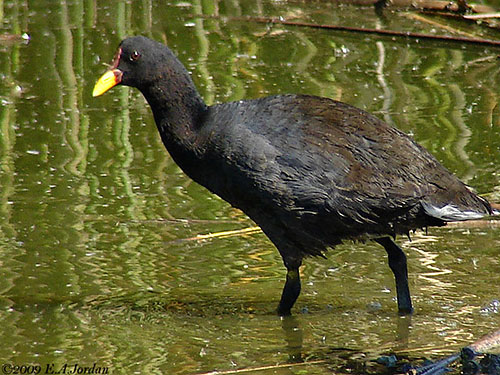
CALLS AND SONGS: SOUNDS BY XENO-CANTO
The Red-fronted Coot gives a long, chattering series of calls described as “togo togo togo…, cu cu cu…, puhúh puhúh puhúh…” and others. We can also hear muffled calls and hooty chuckles.
The alarm call is a “tuc” note.
BEHAVIOUR IN THE WILD:
The Red-fronted Coot feeds primarily at water surface by pecking at vegetation such as duckweed and Azolla mats of family Salviniaceae (Aquatic ferns). But it also submerges the head below the water surface to reach other food items such as molluscs. Outside of the water, it grazes near the marshes when they seasonally dry.
The species is gregarious and often forages and feeds in small flocks, sometimes with Red-gartered Coot.
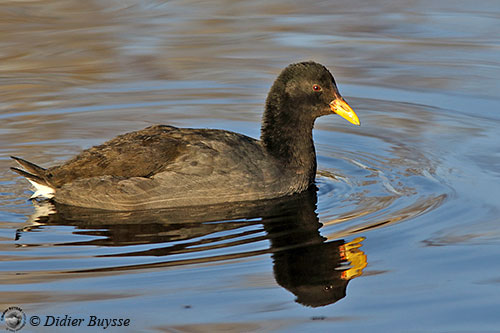
The Red-fronted Coot is monogamous. The courtship displays are unknown. We can suggest that the vocal repertoire is used during the displays. The red frontal shield shows brighter colour and larger size during the breeding season.
Some aggressive displays are observed between males, with the birds beating the water with their wings, and making slapping noises with their feet.
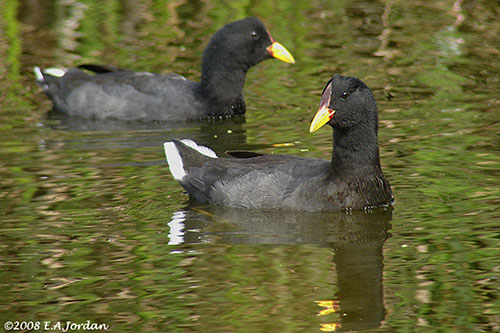
The Red-fronted Coot is not a regular migratory species, but some wandering and dispersal are occasionally reported. At Cape San Antonio in Argentina, the birds leave the area when the marshes dry up during winter. They move at night with other coot species.
The Red-fronted Coot is possibly only a winter inhabitant in the northern part of the Brazilian range.
This species prefers to move at night over large distances or while moving from feeding areas to other marshes. Like most Rallidae species, it has short, broad, rounded wings and only flies when necessary. The bird needs to run over the water surface before to take off.
While swimming, the relatively long tail is raised, displaying the white, heart-shaped outer undertail-coverts.
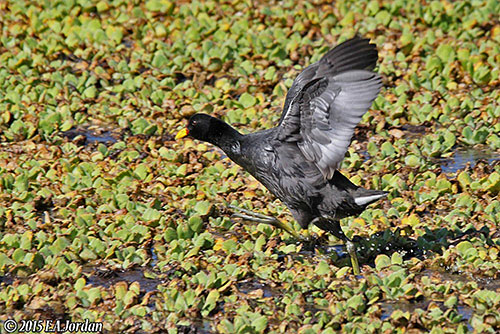
REPRODUCTION OF THIS SPECIES:
The breeding season varies according to the range. The laying takes place in September-October in Chile, in May-November in Argentina, and September-January in Peru. The species is monogamous.
The Red-fronted Coot builds a nest with aquatic vegetation, mainly reeds. It is relatively small comparing to the size of the species, with a diameter of 25-30 cm, and the inner cup measures approximately 13-18 cm in diameter and 3-4 cm deep.
The structure is usually well hidden and at water level, built on floating or emergent vegetation.
The female lays 2-9 (5-6) ochraceous or greenish or olive-brown eggs with brown and grey spots over the entire surface.
The duration of the incubation is unknown. At hatching, the downy chick is black with partly naked, pink and blue crown, and some broad, orange feathers on the throat. The bill is red with some black bands.
At this period, the nest is usually relined with softer material. It is used as brood platform during the first days following the hatching.
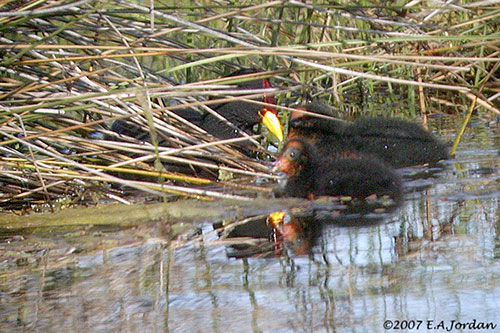
PROTECTION / THREATS / STATUTS:
The Red-fronted Coot is affected by human disturbance involving desertion by adults, especially during the second brood.
The nests of the Red-fronted Coots are often parasitized by the Black-headed Duck (Heteronetta atricapilla). The female lays her eggs in the coot’s nests and the coots incubate them. But the impact on the breeding success is insignificant.
The size of the population is unknown, but it is suspected to be stable.
The Red-fronted Coot is not globally threatened, and the species is currently evaluated as Least Concern.
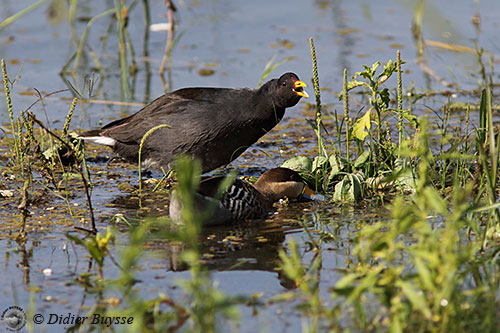
Red-fronted Coot
scolding a Silver Teal